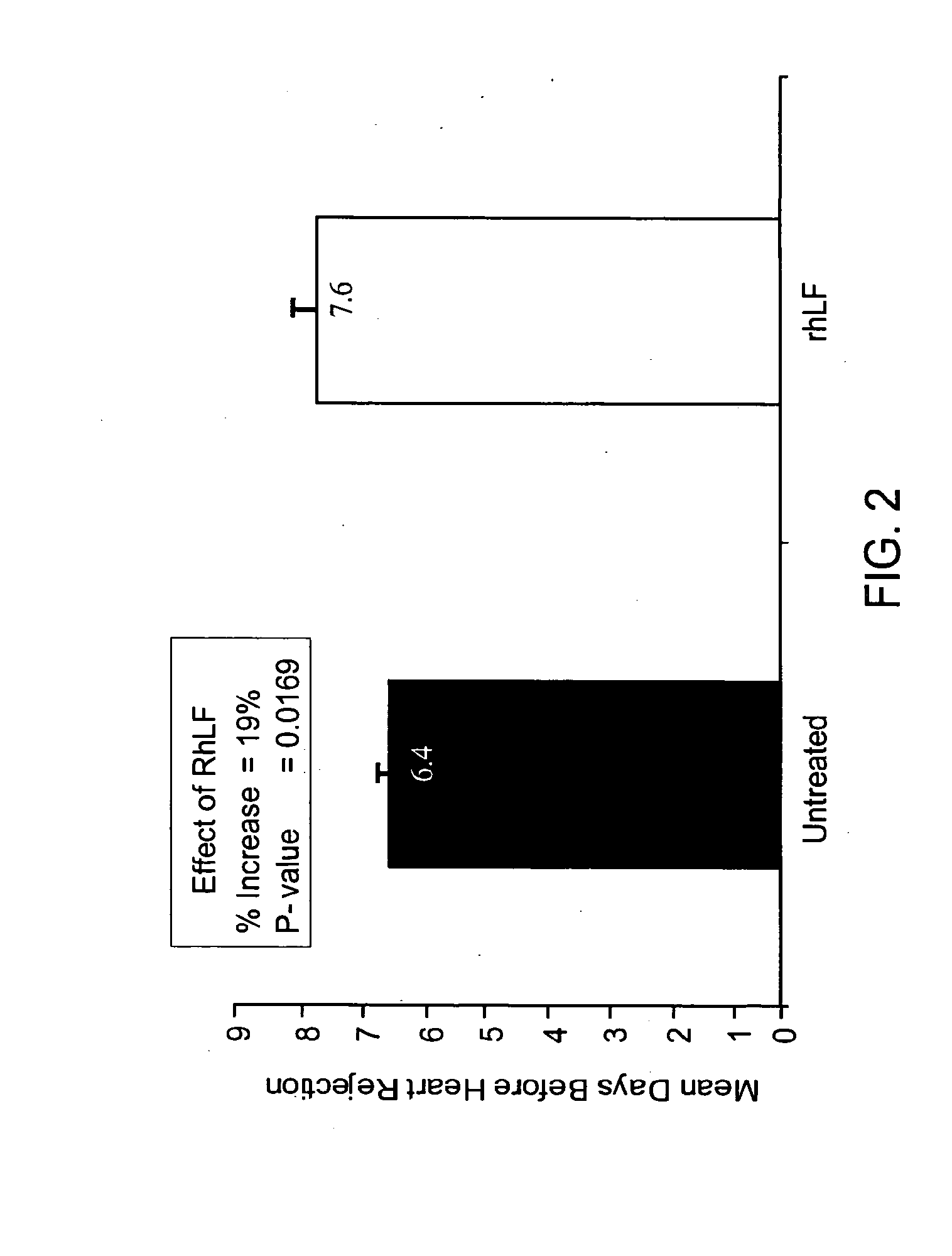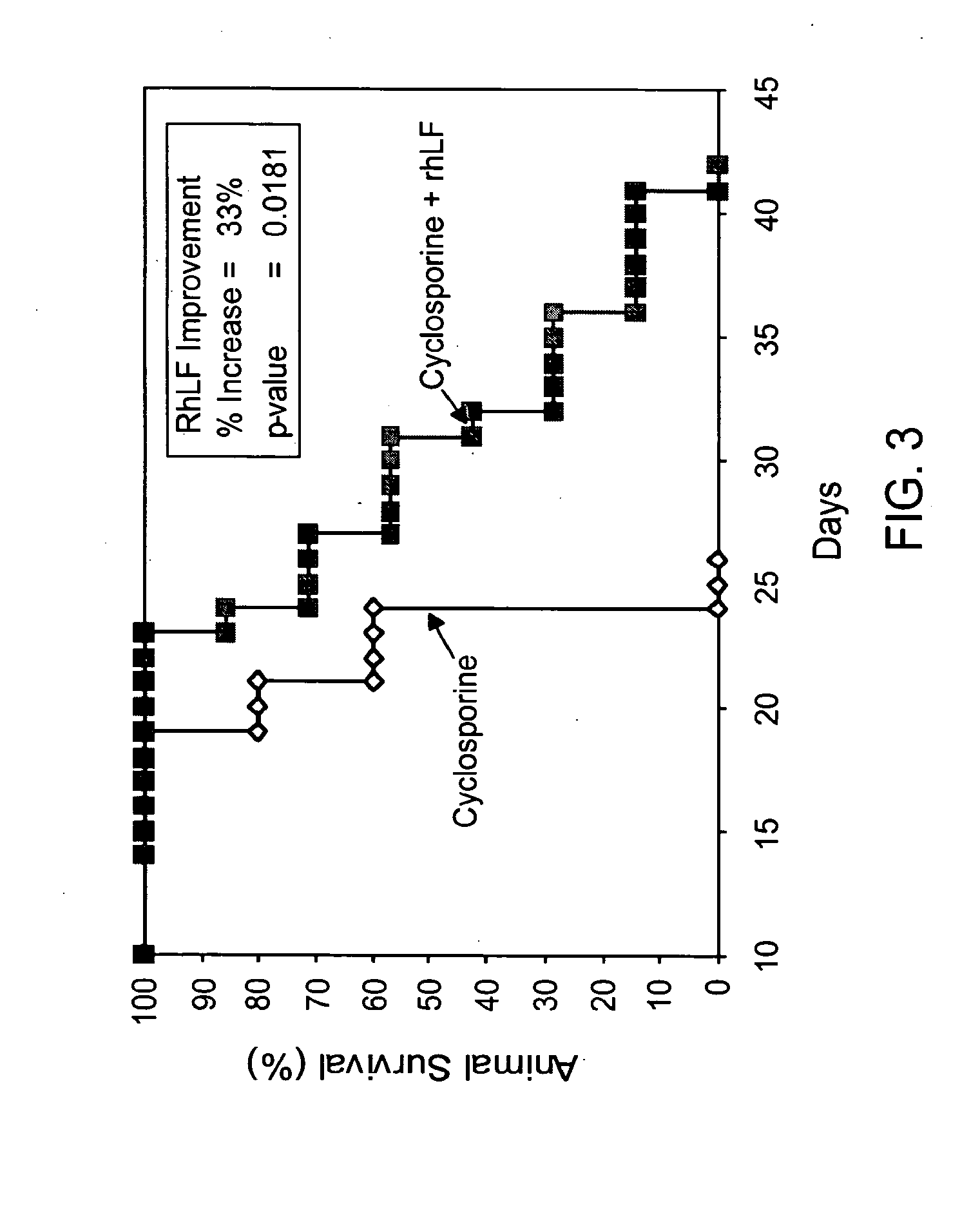Lactoferrin as an agent in the prevention of organ transplant rejection and graft-versus-host-disease
a technology of organ transplant and lactoferrin, which is applied in the direction of biocide, transferrin, peptide/protein ingredients, etc., can solve the problems of chronic rejection remaining a serious issue, organ damage, and three-year mortality rate ranging from 10-40%, and achieve the effect of reducing the incidence of graft-versus-host diseas
- Summary
- Abstract
- Description
- Claims
- Application Information
AI Technical Summary
Benefits of technology
Problems solved by technology
Method used
Image
Examples
example 1
RhLF in Combination with Immunosuppressive Drugs Delays Heart Transplant Rejection
[0109]Hearts were removed from Buffalo rats and transplanted into the abdomen of WF rats using micro vascular surgery. The survival of the transplanted heart was measured daily by palpating for its beat. Transplanted animals either remained untreated (n=5) or were treated with FK506 (0.8 mg / kg once daily×7 days) plus placebo (n=4) or with FK506 (0.8 mg / kg once daily×7 days) plus rhLF (625 mg / kg b.i.d.×14 days followed by 625 mg / kg once daily till rejection; n=7). Drug treatment was started two days prior to the day of transplantation. Average transplant survival of animals treated with FK506 alone (20 days) was not different from animals receiving FK506+placebo (19.3 days) as shown in FIG. 1. RhLF+FK506 was highly statistically different (p<0.01) relative to FK506 alone or FK506+placebo. (See FIG. 1).
example 2
Recombinant Human Lactoferrin (rhLF) Monotherapy Prolongs Allograft Survival
[0110]Heterotopic heart transplantation in 8-10 weeks old rats (BUF, donor to WF, recipient) was performed using standard microsurgical technique of end-to-side anastomoses to recipient aorta and vena cava. Graft survival was defined as the last day of transabdominally palpable cardiac contractions. Recipients were treated with either placebo or rhLF (625 mg / Kg) for 14 days starting seven days prior to the transplant. FIG. 2 illustrates that lactoferrin alone significantly extended cardiac allograft survival.
example 3
RhLF Inhibits Kidney Transplant Rejection
[0111]The activity of rhLF in combination with cyclosporine (CsA) was determined on kidney allograft survival model in rats. Untreated ACI recipients (RT1a) of Lewis (LEW; RT11) kidney allografts survived a mean survival time (MST) of 8.4±0.6 days (n=5). A 14-day treatment with 1.25 mg / kg CsA extended the survival of kidney allografts to 23.0±2.3 days (n=5). FIG. 3 shows that additional treatment of recipients with oral rhLF on days 3 to 14 with 1250 mg / kg and thereafter with 625 mg / kg prolonged survival to 30.6±3.6 days (n=7; p<0.036). These results demonstrate that additional therapy with lactoferrin provided a beneficial effect for kidney allograft survival.
PUM
| Property | Measurement | Unit |
|---|---|---|
| pH | aaaaa | aaaaa |
| composition | aaaaa | aaaaa |
| length | aaaaa | aaaaa |
Abstract
Description
Claims
Application Information
 Login to View More
Login to View More - R&D
- Intellectual Property
- Life Sciences
- Materials
- Tech Scout
- Unparalleled Data Quality
- Higher Quality Content
- 60% Fewer Hallucinations
Browse by: Latest US Patents, China's latest patents, Technical Efficacy Thesaurus, Application Domain, Technology Topic, Popular Technical Reports.
© 2025 PatSnap. All rights reserved.Legal|Privacy policy|Modern Slavery Act Transparency Statement|Sitemap|About US| Contact US: help@patsnap.com



